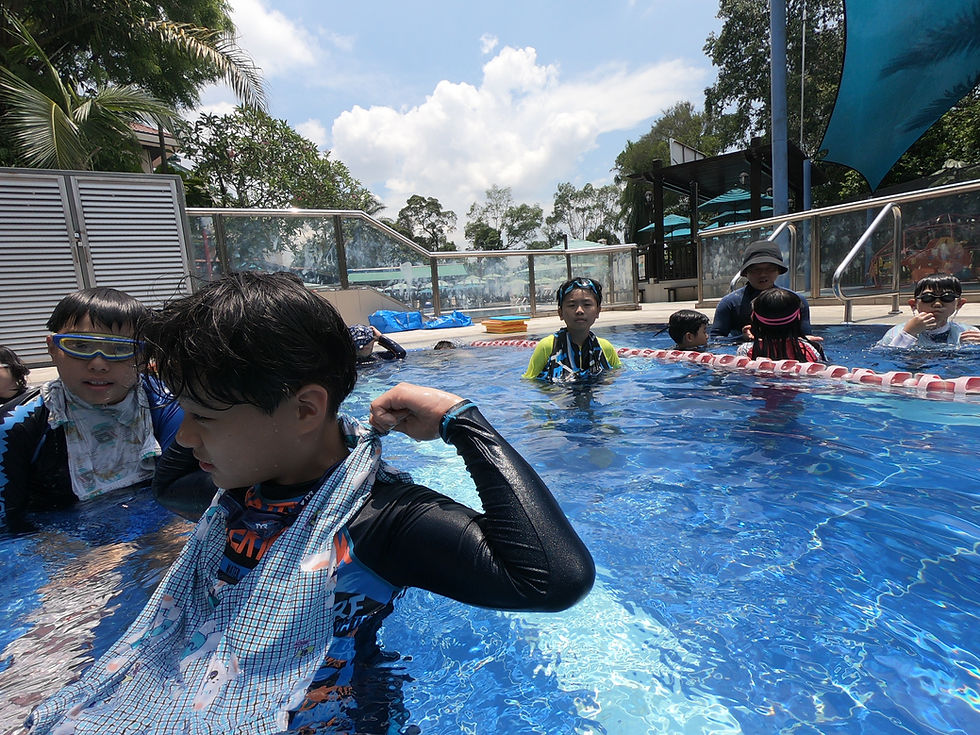How to Transition from Lessons to Independent Pool Time
- SG Sink Or Swim

- May 14, 2025
- 3 min read

Swimming in open water without a wetsuit is a liberating experience — no restriction around your shoulders, no neoprene, just you and the water. Whether you're training for a wetsuit-optional race, seeking greater freedom of movement, or just enjoy the raw connection with nature, ditching the wetsuit takes confidence, skill, and preparation.
In this article, we’ll explore how to swim in open water without a wetsuit, including techniques for adapting to cold water, safety strategies, and performance tips.
🧠 Why Swim Without a Wetsuit?
Wetsuits offer buoyancy and thermal protection, but going without has its own perks:
Increased mobility and stroke efficiency
Better body awareness and technique refinement
Preparation for non-wetsuit legal races
Greater mental and physical toughness
No time spent on wetsuit removal in transitions (triathlon bonus!)
But it’s not as simple as jumping in — preparation is essential for a safe and successful swim.
🌊 1. Get Acclimated to Cold Water
Without a wetsuit, you'll feel the water temperature immediately. If you're not used to cooler temperatures, this can lead to cold shock or hyperventilation.
🔹 How to Prepare:
Start with short acclimatization swims in similar conditions.
Breathe slowly and stay calm when first entering.
Use a cold shower or tub to condition your body ahead of time.
Gradually increase duration over several sessions.
✅ Train your mind and body to stay relaxed in colder water.
💪 2. Improve Your Body Position and Technique
Wetsuits offer added buoyancy, especially in the hips and legs. Without that lift, any flaws in your technique become more noticeable — and costly in terms of energy.
🔹 Focus On:
Strong core engagement to stay level
High elbow catch to generate lift and propulsion
Steady kick rhythm to prevent legs from sinking
Head positioning — looking too far forward will drop your hips
✅ Use pool drills like body balance work, kickboard-free kicking, and sculling to prepare.
🏊♂️ 3. Adjust Your Sighting and Navigation
Open water requires regular sighting to stay on course, especially without lane lines or a wetsuit's extra floatation.
🔹 Tips for Better Sighting:
Sight every 6–8 strokes or as needed, depending on chop and visibility.
Combine sighting with your breathing to avoid extra head lift.
Practice in the pool with sighting drills to refine technique.
✅ Keep your movement streamlined even during sighting.
🔥 4. Layer with Minimal Gear if Needed
Going "wetsuit-free" doesn't mean totally unprotected. Depending on the rules and your goals, minimal gear can help:
Swim cap or thermal cap for heat retention
Swim socks or gloves (if allowed in training)
Vaseline or body glide to reduce cold water shock and chafing
✅ Choose comfort and safety over pride when training.
🧭 5. Train for Endurance and Thermoregulation
Swimming without a wetsuit often requires more energy output and quicker heat loss. To compensate, build your:
Cardiovascular endurance — longer continuous swims
Cold water tolerance — progressive open water sessions
Nutrition and hydration plan — fuel properly before and after your swim
✅ Don’t underestimate the toll of a non-wetsuit swim, especially in rough or cold conditions.
🛟 6. Prioritize Safety Every Time
Open water always requires precautions, and even more so when swimming without the insulation of a wetsuit.
🔹 Safety Checklist:
Swim with a buddy or group
Wear a bright swim cap and tow float
Know the water temperature and weather forecast
Identify entry/exit points before entering the water
Let someone know your swim route and ETA
✅ Avoid swimming alone in cold, deep, or unfamiliar water.
🏁 Final Thoughts
Swimming in open water without a wetsuit is an advanced and rewarding step in any swimmer’s development. It builds grit, sharpens technique, and gives you the freedom to connect with the water in its most natural form.
With the right training, safety practices, and mental readiness, you’ll not only swim smarter — you’ll swim stronger.





Comments